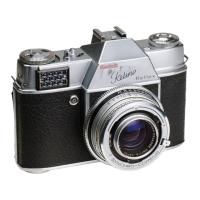You will also notice that the depth of field is greater at far distances than near ones. At 5 ft. and f2.8 the sharp
zone covers from 4¾ ft. to 5½ ft. -- less than 1 ft. all together -- against 2 ft. at the 9 ft. setting and some 15-
20 ft. at 25 ft.
Two more points on depth of field.
First, the depth obtained depends also on the focal length of the lens. Short focus lenses yield more depth and
tele lenses less depth. That is why the alternative lens units of the Retina Reflex have their own depth of field
indicator.
Secondly, the sharp zones obtained by the indicator are based on a somewhat arbitrary assumption of how
much blurring is acceptable. So depth of field data for different cameras with the same lens may not always
agree, and you are also quite safe in rounding off figures obtained from such data. And if you intend to make
realty big enlargements from your negatives, you can use stricter standards of sharpness by simply stopping
down the lens by one stop.
The depth of field scale shows clearly how much of the subject will be sharp at any given distance and aperture.
The figure opposite the triangular index mark (top) is the focused distance (8 ft). The figures to either side of
the index mark represent aperture settings. If we then read off the distance opposite the aperture settings, we
see indicated the area of sharp focus. So with an aperture of f16 this area extends from just under 5 ft. to about
50 ft. But at f4 the depth of field is more limited, from just over 5 ft. to about 10 ft.
On the Retina Reflex S and III two pointers automatically show the depth of field zone (bottom). The pointers
are coupled with the aperture control and move apart at small stop settings and together at large apertures.
Zone Focusing
With action subjects and similar occasions where you want to shoot quickly, determining sharp zones even with
the depth of field indicator wastes too much time. There you need prepared settings covering given near and
medium distance ranges that you can easily memorize and set on the camera. The focusing zone table (p.49)
gives such settings : then you only have to worry about keeping the subject within that zone while you shoot.
FLASH WITH THE RETINA REFLEX
Flash is an efficient light source where no or insufficient daylight is available such as at night, indoors, etc. In
the flashlight you carry you own private "sun" with which you can illuminate your subject or scene at any time
and place.

